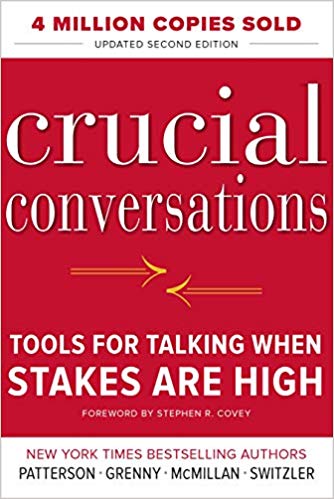

This article is an excerpt from the Shortform summary of "Crucial Conversations" by Kerry Patterson. Shortform has the world's best summaries of books you should be reading.
Like this article? Sign up for a free trial here .
How do you know when to apologize? Is there a way to know if you should apologize during a crucial conversation?
Knowing when to apologize is hard, and even the best communicators struggle with knowing when to apologize and how. During crucial conversations, apologies can be necessary to keep the conversation on track.
When to Apologize: To Make the Content Safe
We’ve all been part of conversations in which we didn’t feel safe to say what was on our mind. This chapter explains what to do to fix that, and when to apologize for creating an unsafe environment. It also goes over when not to apologize in a relationship. The basic steps in brief are:
- Step away from the content of the conversation.
- Determine whether mutual purpose or mutual respect is at risk.
- Restore safety by restoring mutual purpose or respect (Use skills: apologize, contrast, rebuild mutual purpose; or, if you don’t already have a mutual purpose, create one using CRIB: Commit, Respect, Invent, Brainstorm).
- Rejoin the conversation: Return to the issue at hand.
But when should you apologize? Here’s a look at each step in detail, and a breakdown of
When to Apologize: To Ensure Mutual Purpose and Respect
One example of when to apologize is when you lose track of the conversation. Maybe it even gets derailed by a debate over when not to apologize in a relationship. Once you step away from the content of a conversation, there are three skills you can use to restore either mutual purpose or mutual respect: apologize, contrast, create a mutual purpose.
Apologize if Warranted
When your behavior has made others doubt your respect or commitment to the shared purpose, offer a sincere apology. If you made a mistake that hurt others, express your regret. To be sincere, your motives have to change: You have to give up saving face, being right, or winning in order to focus on what you really want. When you sacrifice your ego, you’ll get something more important — productive dialogue.
If your apology has helped restore safety, you can then explain what happened, then return to the original issue. If it hasn’t, you’ll have to draw on other dialogue skills (more on that in a moment). This is a great example of the answer to when should you apologize.
Example: Apology
A company’s employees worked extra hours on a presentation for a visiting vice president. But when the VP arrived, the employees’ manager monopolized the visit without introducing her to them.
After the visit, employees reacted angrily. Before anything else could be accomplished, the manager needed to apologize for causing hurt and disrespect, by not sharing the change in plans. Then he could explain what happened: the VP had presented a plan detrimental to the company and its employees, and the manager had spent the visit persuading her to revamp it.
Use Contrasting to Apologize
Sometimes when you’re sharing your views in crucial conversations, others believe unjustifiably that you’re out to harm or coerce them. You shouldn’t apologize because you haven’t done anything wrong – this would be disingenuous. To rebuild mutual purpose/mutual respect when others misinterpret your purpose or intent, you can use the skill of contrasting when you’re learning when to apologize.
Contrasting is a two-part don’t/do statement that assures others that you respect them and clarifies your purpose. You explain what you don’t want, followed by what you do want.
Contrasting works this way (using the example of the manager explaining the VP visit to employees):
- “I don’t want to imply that I don’t value your work.” (What the manager doesn’t want)
- “I think your work has been outstanding and I want the leadership to understand the value of what you do.” (What he does want)
Of the two parts of contrasting, the don’t is more important because it deals with the misunderstanding that has undermined safety. You address the misunderstanding first, then explain what you intended.
In the Yvonne/Jotham conversation earlier, Yvonne could use contrasting when she returns to the conversation on intimacy: “I don’t want to put this all on you — it’s on both of us. What I do want is to be able to talk about it so we can improve things for both of us.”
Contrasting isn’t apologizing — it provides context and proportion. Sometimes when others take your words the wrong way, you’re tempted to water down what you’re trying to say. Don’t backpedal, but put your words in context: “Let me put this in perspective…I don’t mean to imply…”
You can use contrasting preemptively as well, to enhance safety when what you’re about to say could spark defensiveness: “I don’t want you to think I don’t appreciate…but”
Practical tip: When people take something the wrong way and you start arguing over the misunderstanding, stop and use contrasting. Explain what you don’t mean until it’s safe to return to the conversation.
Drawing the Conversation Back
First, the suggestion: One way people have succeeded in improving their handling of crucial conversations is by focusing on just two key principles: Pay attention to what’s happening, and ensure safety. This is also a key idea to knowing when not to apologize in a relationship: paying attention to these steps can help you make that decision.
1. Pay attention to what’s happening: Constantly ask yourself whether you’re in or out of dialogue. This makes a huge difference.
Even if you can’t remember the acronyms or steps you can help maintain dialogue by noticing whether you or others are falling into silence or violence. Even if you don’t know exactly how to fix the problem when you see it, it’s worth trying something to restore the dialogue.
You can use the statement, “I think we’ve moved away from dialogue,” to get back on track.
2. Ensure safety: When you notice that you and others have moved away from dialogue, do something to make it safer — for instance, asking a question and showing interest in others’ views.
Just do something to make others comfortable: smile, apologize if you’ve moved to silence or violence, or request a brief timeout. Although the book suggests specific skills (such as contrasting, mirroring, priming), there are many other things you can do to increase safety. A positive response can also help you learn when to apologize in the future.
So when should you apologize? As you work on your communication skills during crucial conversations, you’ll get a better sense of when to apologize. Sometimes, it’s even necessary to apologize when you don’t think you did anything wrong. But learning when to apologize is a part of learning to be the best communicator you can be.

———End of Preview———
Like what you just read? Read the rest of the world's best summary of Kerry Patterson's "Crucial Conversations" at Shortform .
Here's what you'll find in our full Crucial Conversations summary :
- How to approach an argument without getting mad
- The mistakes most people make when trying to listen to someone else
- How to come up with win-win solutions that make everyone happy






